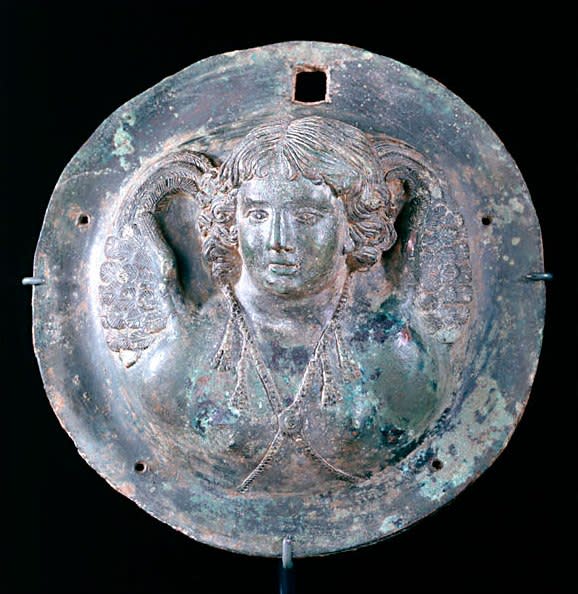Roman Bronze Roundel Depicting Cupid, 1st Century CE - 3rd Century CE
Bronze
height 17.1 cm
height 6 3/4 in
height 6 3/4 in
X.0193
Decorative roundels like this marvelous bronze example are some of the more mysterious objects in the whole of Roman art. While we know they served as adornments, the objects they...
Decorative roundels like this marvelous bronze example are some of the more mysterious objects in the whole of Roman art. While we know they served as adornments, the objects they once embellished, ranging from pieces of furniture to chariots, were assembled from less durable materials and have long since disappeared, leaving behind these decorations. The only clue we have to their placement is the series of small round holes and the larger square hole that penetrate the flat rim. It is likely that a large nail would have been driven into the roundel in order to secure it in place on the object it once adorned, be it chest or chair. Nails may have been driven into the smaller holes as added support. However, it is also possible that a wooden frame may have been nailed into place using these holes. The advantages of this theory are twofold: the frame would have both covered the unattractive nail in the top center and served visually as a transition between the bronze of the roundel and the wood of the object to which it was attached.
The figure of winged Cupid, the mischievous god of love, smiles down upon us. Rendered in high relief, he appears the idealized vision of male youth, with a fleshy, full face, long, wavy locks of hair, and a longing, melancholic gaze. His wings have been sculpted with expert attention, with every feather noted and the individual texture of each feather highlighted with delicately incised lines. Such detail is also visible in his curly hair, where the individual strands have been suggested by similar incising. His pupils have been indicated by two small dots that may have once been inlaid with silver in order to heighten the naturalism of his stare. His chest is covered with two tasseled straps that cross over one another. They have a texture suggesting that there are either beaded or woven. A small round pendant marks the join where the two straps overlap. Perhaps these straps are connected to his quiver that Cupid presumably carries on his back. This masterpiece of Roman art was originally a decorative element meant to embellish a luxurious piece of furniture. Today, however, this roundel serves as an independent work of art that can be appreciated and admired on its own.
The figure of winged Cupid, the mischievous god of love, smiles down upon us. Rendered in high relief, he appears the idealized vision of male youth, with a fleshy, full face, long, wavy locks of hair, and a longing, melancholic gaze. His wings have been sculpted with expert attention, with every feather noted and the individual texture of each feather highlighted with delicately incised lines. Such detail is also visible in his curly hair, where the individual strands have been suggested by similar incising. His pupils have been indicated by two small dots that may have once been inlaid with silver in order to heighten the naturalism of his stare. His chest is covered with two tasseled straps that cross over one another. They have a texture suggesting that there are either beaded or woven. A small round pendant marks the join where the two straps overlap. Perhaps these straps are connected to his quiver that Cupid presumably carries on his back. This masterpiece of Roman art was originally a decorative element meant to embellish a luxurious piece of furniture. Today, however, this roundel serves as an independent work of art that can be appreciated and admired on its own.
